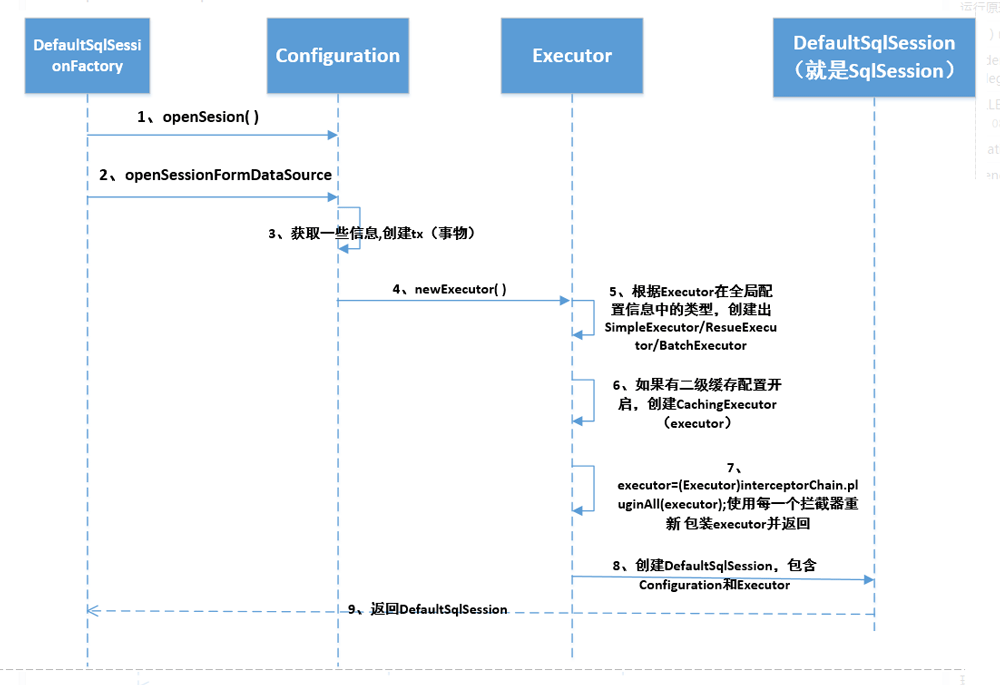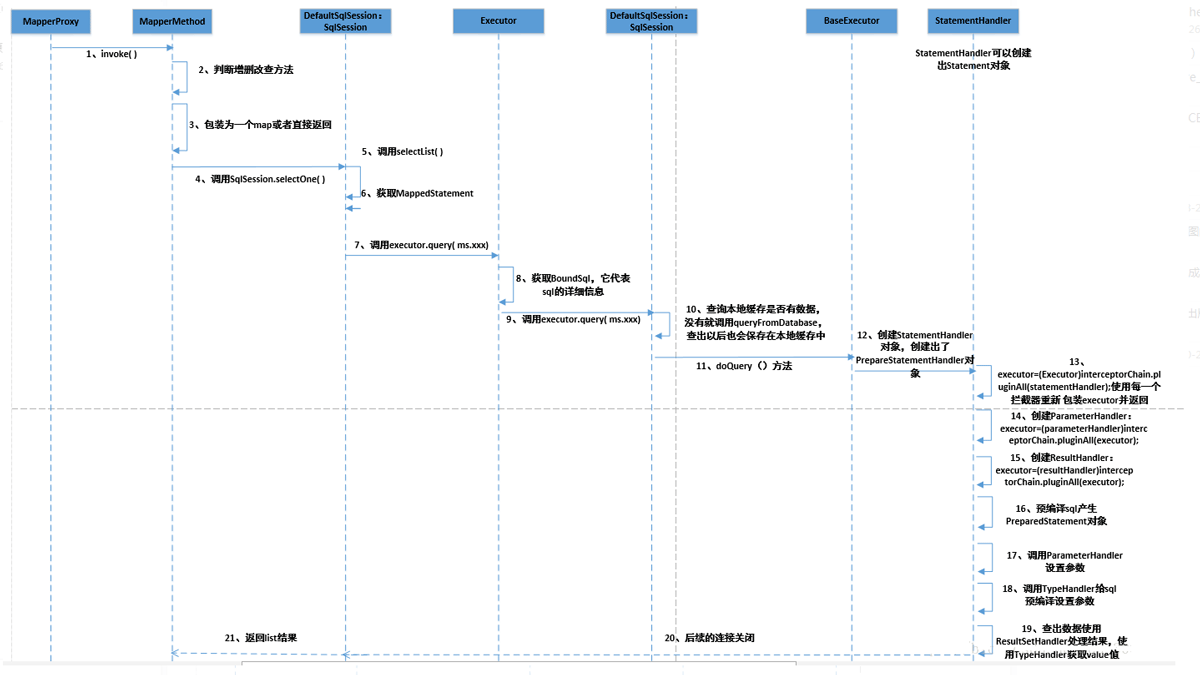SQL语句解析执行的过程及原理
来源:脚本之家
时间:2022-12-30 12:04:32 119浏览 收藏
亲爱的编程学习爱好者,如果你点开了这篇文章,说明你对《SQL语句解析执行的过程及原理》很感兴趣。本篇文章就来给大家详细解析一下,主要介绍一下解析、执行、SQL语句、过程,希望所有认真读完的童鞋们,都有实质性的提高。
一、sqlSession简单介绍
- 拿到
SqlSessionFactory对象后,会调用SqlSessionFactory的openSesison方法,这个方法会创建一个Sql执行器(Executor),这个Sql执行器会代理你配置的拦截器方法。 - 获得上面的Sql执行器后,会创建一个
SqlSession(默认使用DefaultSqlSession),这个SqlSession中也包含了Configration对象,所以通过SqlSession也能拿到全局配置; - 获得
SqlSession对象后就能执行各种CRUD方法了。

二、获得sqlSession对象源码分析
/**
* 通过sqlSessionFactory.openSession进行获取sqlSession对象
* 源码位置:org.apache.ibatis.session.defaults.DefaultSqlSessionFactory.openSession()
*/
public SqlSession openSession() {
return openSessionFromDataSource(configuration.getDefaultExecutorType(), null, false);
}
/**
* 通过数据源去获取SqlSession
* 源码位置:org.apache.ibatis.session.defaults.DefaultSqlSessionFactory.openSessionFromDataSource(ExecutorType, TransactionIsolationLevel, boolean)
*/
private SqlSession openSessionFromDataSource(ExecutorType execType, TransactionIsolationLevel level,
boolean autoCommit) {
Transaction tx = null;
try {
// 获取环境变量
final Environment environment = configuration.getEnvironment();
// 获取事务工厂
final TransactionFactory transactionFactory = getTransactionFactoryFromEnvironment(environment);
// 获取一个事务
tx = transactionFactory.newTransaction(environment.getDataSource(), level, autoCommit);
// 获取执行器,这边获得的执行器已经代理拦截器的功能
final Executor executor = configuration.newExecutor(tx, execType);
// 根据获取的执行器创建SqlSession
return new DefaultSqlSession(configuration, executor, autoCommit);
} catch (Exception e) {
closeTransaction(tx); // may have fetched a connection so lets call close()
throw ExceptionFactory.wrapException("Error opening session. Cause: " + e, e);
} finally {
ErrorContext.instance().reset();
}
}
/**
* 获取执行器
* 源码位置:org.apache.ibatis.session.defaults.DefaultSqlSessionFactory.openSessionFromDataSource(ExecutorType, TransactionIsolationLevel, boolean)
*/
public Executor newExecutor(Transaction transaction, ExecutorType executorType) {
// 默认使用SIMPLE的执行器
executorType = executorType == null ? defaultExecutorType : executorType;
executorType = executorType == null ? ExecutorType.SIMPLE : executorType;
Executor executor;
if (ExecutorType.BATCH == executorType) {
// 批量的执行器
executor = new BatchExecutor(this, transaction);
} else if (ExecutorType.REUSE == executorType) {
// 可重复使用的执行器
executor = new ReuseExecutor(this, transaction);
} else {
// 简单的sql执行器
executor = new SimpleExecutor(this, transaction);
}
// 判断Mybatis的全局配置文件是否开启二级缓存
if (cacheEnabled) {
// 开启缓存,吧executor包装为CachingExecutor
executor = new CachingExecutor(executor);
}
// 插件的调用:责任链模式
executor = (Executor) interceptorChain.pluginAll(executor);
return executor;
}
三、SQL执行流程,以查询为例

/**
* 查询的入口方法
* 源码位置:org.apache.ibatis.session.defaults.DefaultSqlSession.selectOne(String, Object)
*/
public <t> T selectOne(String statement, Object parameter) {
// Popular vote was to return null on 0 results and throw exception on too many.
// 查询数据
List<t> list = this.<t>selectList(statement, parameter);
// 长度为1,拿第一个
if (list.size() == 1) {
return list.get(0);
} else if (list.size() > 1) {
// 长度大于一,抛异常
throw new TooManyResultsException(
"Expected one result (or null) to be returned by selectOne(), but found: " + list.size());
} else {
// 没有拿到返回null
return null;
}
}
/**
* 查询数据
* 源码位置:org.apache.ibatis.session.defaults.DefaultSqlSession.selectList(String, Object, RowBounds)
*/
public <e> List<e> selectList(String statement, Object parameter, RowBounds rowBounds) {
try {
// 通过statement去全局配置文件中获取MappedStatement(得到mapper中增删改查的节点)
MappedStatement ms = configuration.getMappedStatement(statement);
// 通过执行器去执行SQL
return executor.query(ms, wrapCollection(parameter), rowBounds, Executor.NO_RESULT_HANDLER);
} catch (Exception e) {
throw ExceptionFactory.wrapException("Error querying database. Cause: " + e, e);
} finally {
ErrorContext.instance().reset();
}
}
/**
* 执行查询操作的准备工作
* 源码位置:org.apache.ibatis.executor.CachingExecutor.query(MappedStatement, Object, RowBounds, ResultHandler)
*/
public <e> List<e> query(MappedStatement ms, Object parameterObject, RowBounds rowBounds,
ResultHandler resultHandler) throws SQLException {
// 通过参数进行sql解析
BoundSql boundSql = ms.getBoundSql(parameterObject);
CacheKey key = createCacheKey(ms, parameterObject, rowBounds, boundSql);
return query(ms, parameterObject, rowBounds, resultHandler, key, boundSql);
}
/**
* 执行查询操作的准备工作
* 源码位置:org.apache.ibatis.executor.CachingExecutor.query(MappedStatement, Object, RowBounds, ResultHandler, CacheKey, BoundSql)
*/
public <e> List<e> query(MappedStatement ms, Object parameterObject, RowBounds rowBounds,
ResultHandler resultHandler, CacheKey key, BoundSql boundSql) throws SQLException {
// 判断sql是否开启了缓存 <cache></cache>
Cache cache = ms.getCache();
// 有缓存
if (cache != null) {
// 判断是否需要刷新缓存
flushCacheIfRequired(ms);
if (ms.isUseCache() && resultHandler == null) {
ensureNoOutParams(ms, boundSql);
@SuppressWarnings("unchecked")
// 去二级缓存中获取(装饰者模式)
List<e> list = (List<e>) tcm.getObject(cache, key);
// 二级缓存没有找到
if (list == null) {
// 查询数据,并放入缓存
list = delegate.<e>query(ms, parameterObject, rowBounds, resultHandler, key, boundSql);
tcm.putObject(cache, key, list); // issue #578 and #116
}
return list;
}
}
// 查询数据
return delegate.<e>query(ms, parameterObject, rowBounds, resultHandler, key, boundSql);
}
/**
* 一级缓存查询的调用
* 源码位置:org.apache.ibatis.executor.BaseExecutor.query(MappedStatement, Object, RowBounds, ResultHandler, CacheKey, BoundSql)
*/
public <e> List<e> query(MappedStatement ms, Object parameter, RowBounds rowBounds, ResultHandler resultHandler,
CacheKey key, BoundSql boundSql) throws SQLException {
ErrorContext.instance().resource(ms.getResource()).activity("executing a query").object(ms.getId());
// 已经关闭了,抛异常
if (closed) {
throw new ExecutorException("Executor was closed.");
}
// 清空本地缓存
if (queryStack == 0 && ms.isFlushCacheRequired()) {
clearLocalCache();
}
List<e> list;
try {
// 从一级缓存中获取数据
queryStack++;
list = resultHandler == null ? (List<e>) localCache.getObject(key) : null;
if (list != null) {
// 缓存里面有,进行处理
handleLocallyCachedOutputParameters(ms, key, parameter, boundSql);
} else {
// 缓存没有,进行查询
list = queryFromDatabase(ms, parameter, rowBounds, resultHandler, key, boundSql);
}
} finally {
queryStack--;
}
if (queryStack == 0) {
for (DeferredLoad deferredLoad : deferredLoads) {
deferredLoad.load();
}
// issue #601
deferredLoads.clear();
if (configuration.getLocalCacheScope() == LocalCacheScope.STATEMENT) {
// issue #482
clearLocalCache();
}
}
return list;
}
/**
* 在数据库中查询
* 源码位置:org.apache.ibatis.executor.BaseExecutor.queryFromDatabase(MappedStatement, Object, RowBounds, ResultHandler, CacheKey, BoundSql)
*/
private <e> List<e> queryFromDatabase(MappedStatement ms, Object parameter, RowBounds rowBounds,
ResultHandler resultHandler, CacheKey key, BoundSql boundSql) throws SQLException {
List<e> list;
localCache.putObject(key, EXECUTION_PLACEHOLDER);
try {
// 去数据库查询
list = doQuery(ms, parameter, rowBounds, resultHandler, boundSql);
} finally {
localCache.removeObject(key);
}
// 一级缓存进行缓存
localCache.putObject(key, list);
if (ms.getStatementType() == StatementType.CALLABLE) {
localOutputParameterCache.putObject(key, parameter);
}
return list;
}
/**
* 查询逻辑
* 源码位置:org.apache.ibatis.executor.SimpleExecutor.doQuery(MappedStatement, Object, RowBounds, ResultHandler, BoundSql)
*/
public <e> List<e> doQuery(MappedStatement ms, Object parameter, RowBounds rowBounds, ResultHandler resultHandler,
BoundSql boundSql) throws SQLException {
Statement stmt = null;
try {
// 得到整体的配置对象
Configuration configuration = ms.getConfiguration();
// 内部封装了ParameterHandler和ResultSetHandler
StatementHandler handler = configuration.newStatementHandler(wrapper, ms, parameter, rowBounds,
resultHandler, boundSql);
stmt = prepareStatement(handler, ms.getStatementLog());
// 执行查询
return handler.<e>query(stmt, resultHandler);
} finally {
closeStatement(stmt);
}
}
/**
* 执行查询语句
* 源码位置:org.apache.ibatis.executor.statement.SimpleStatementHandler.query(Statement, ResultHandler)
*/
public <e> List<e> query(Statement statement, ResultHandler resultHandler) throws SQLException {
// 得到要执行的sql
String sql = boundSql.getSql();
// 执行sql
statement.execute(sql);
// 处理结果集
return resultSetHandler.<e>handleResultSets(statement);
}</e></e></e></e></e></e></e></e></e></e></e></e></e></e></e></e></e></e></e></e></e></e></e></t></t></t>
文中关于mysql的知识介绍,希望对你的学习有所帮助!若是受益匪浅,那就动动鼠标收藏这篇《SQL语句解析执行的过程及原理》文章吧,也可关注golang学习网公众号了解相关技术文章。
声明:本文转载于:脚本之家 如有侵犯,请联系study_golang@163.com删除
相关阅读
更多>
-
131 收藏
-
329 收藏
-
203 收藏
-
368 收藏
-
375 收藏
最新阅读
更多>
-
119 收藏
-
127 收藏
-
137 收藏
-
473 收藏
-
140 收藏
-
252 收藏
-
434 收藏
-
233 收藏
-
385 收藏
-
412 收藏
-
320 收藏
-
432 收藏
课程推荐
更多>
-

- 前端进阶之JavaScript设计模式
- 设计模式是开发人员在软件开发过程中面临一般问题时的解决方案,代表了最佳的实践。本课程的主打内容包括JS常见设计模式以及具体应用场景,打造一站式知识长龙服务,适合有JS基础的同学学习。
- 立即学习 543次学习
-

- GO语言核心编程课程
- 本课程采用真实案例,全面具体可落地,从理论到实践,一步一步将GO核心编程技术、编程思想、底层实现融会贯通,使学习者贴近时代脉搏,做IT互联网时代的弄潮儿。
- 立即学习 516次学习
-

- 简单聊聊mysql8与网络通信
- 如有问题加微信:Le-studyg;在课程中,我们将首先介绍MySQL8的新特性,包括性能优化、安全增强、新数据类型等,帮助学生快速熟悉MySQL8的最新功能。接着,我们将深入解析MySQL的网络通信机制,包括协议、连接管理、数据传输等,让
- 立即学习 500次学习
-

- JavaScript正则表达式基础与实战
- 在任何一门编程语言中,正则表达式,都是一项重要的知识,它提供了高效的字符串匹配与捕获机制,可以极大的简化程序设计。
- 立即学习 487次学习
-

- 从零制作响应式网站—Grid布局
- 本系列教程将展示从零制作一个假想的网络科技公司官网,分为导航,轮播,关于我们,成功案例,服务流程,团队介绍,数据部分,公司动态,底部信息等内容区块。网站整体采用CSSGrid布局,支持响应式,有流畅过渡和展现动画。
- 立即学习 485次学习
